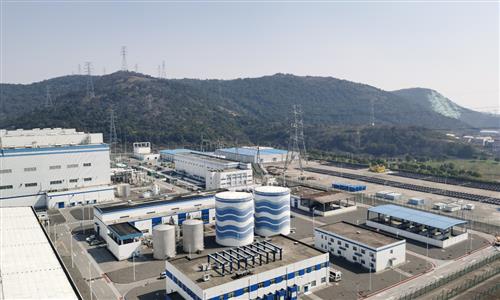Qinshan Nuclear Power plant located in Haiyan county, East China's Zhejiang Province Photo: Hu Yuwei/GT
As of now, China has 102 nuclear power units, including those in operation, under construction and approved for construction, with a total installed capacity of 113 million kilowatts, ranking first globally, in terms of the overall scale, for the first time, according to a blue book - China Nuclear Energy Development Report 2025, the Global Times learnt from the China Nuclear Energy Association (CNEA) on Sunday.
As of the end of 2024, China had 28 nuclear power units under construction, and the installed capacity of the units under construction has held the top spot globally for 18 consecutive years, according to the blue book.
In 2024, China's cumulative electricity generation from nuclear power reached 444.7 billion kilowatt-hours, accounting for 4.72 percent of the country's total electricity generation, and ranking second globally. The annual equivalent reduction in carbon dioxide emissions was approximately 334 million tons.
Based on the current construction pace, China's operational nuclear power installed capacity is expected to rank first globally before 2030, according to the report issued by the CNEA.
By 2024, China had achieved 100 percent localization of key main equipment for nuclear power and ensured the independent control of key component technologies. The cumulative delivery of domestic nuclear power main equipment for the entire year reached 114 sets in 2024, doubling the amount delivered in 2023, it said.
Cao Shudong, an executive vice chairman of CNEA, said that China's independent research and development continues to achieve new breakthroughs. Cao said that unit one of the national major science and technology project Guohe One demonstration project has been completed and put into operation, while the Linglong One project is expected to be completed and put into operation in 2026.
The report also advises promoting the balanced development of nuclear power, such as making full use of existing coastal nuclear power plant sites to actively and orderly advance project development.
It also said that China's international cooperation in nuclear energy has made continuous progress, including strengthening communication and cooperation with the International Atomic Energy Agency, and opening up 12 nuclear research facilities and experimental platforms to the world, according to the report. Nuclear energy cooperation with Russia, France and other countries and regions is continuously expanding and deepening.
The blue book was issued at the spring summit - International Forum on Nuclear Energy Sustainable Development, which was organized by the CNEA, on Sunday. Dong Baotong, head of the National Nuclear Safety Administration, said that China's nuclear power has entered a peak period of large-scale construction, according to the CNEA.
Currently, influenced by factors such as climate change, ensuring energy security and the surging demand for electricity due to the construction of data centers, the global nuclear energy sector is entering a new phase of industrial revival and innovative development, Dong said.
Dong said it is essential to ensure that the operation of nuclear power units maintains a high level of nuclear safety.
Huang Haihua, a spokesperson for the Legislative Affairs Commission of the National People's Congress (NPC) Standing Committee, told a press conference on April 25 that the Standing Committee of the 14th NPC will hold its 15th session in Beijing from Sunday to Wednesday. Lawmakers will review several draft laws, including draft law on atomic energy, according to Huang.
Related:


